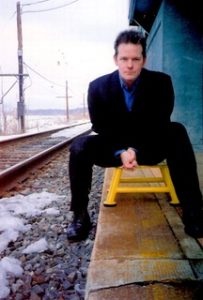Taking Your Act Online? Resources to Up Your Tech Game
(Part One of a two-part article.)
The virtual performance wave brings a need for performers to be tech savvy. As we turn our living rooms, bedrooms, and basements into performance spaces, performers find themselves having to confront the technical issues of putting together a show in an entirely different way.
While dealing with technical issues can be scary for any performer, there is good news here: The first is that many of the people who have spent their lives working in the tech end of live entertainment have turned their attention to helping artists reach audiences in new ways that will be with us well beyond this current moment; the second is that artists thinking about taking advantage of the boom in online shows have several options open to them.
Before going into these options, let’s talk about what makes a thoroughly watchable online experience—beyond a solid performance with great song choices.
1) Aim to be Glitch-Free

According to Stuart Allyn, recording engineer and sound designer for numerous Broadway shows and who is currently consulting with artists on sound issues on his own and through the company Musae, “A good show is a show that looks clean, professional, and sounds great. Also, one with no glitches either technical or performance-related.”
Matt Berman technical director for such artists as Kristin Chenoweth, Liza Minnelli, and Brian Stokes Mitchell, states “If the audience can watch a show without ever being taken out of the moment by a huge technical problem or a smaller constant problem, then it can be considered a successful show. Very much the same as live performance. If there’s anything that’s pulling you away from the performance, that’s a problem.”
2) Keep an Eye on Your Watch
Length is also something to take into consideration. Allyn continues, “A performer needs to think about the fact that the audience is remote, so the times between songs should be short. People sitting at home alone may clap for a few moments but not like the energy you have in a real venue. Without the energy of a live audience, the viewers can only sustain their interest on a computer screen for so long.”
3) Dote on Décor
Finally, it’s important to consider what Allyn calls, “a nicely adorned playing space.” In other words, your background. Berman cautions, “Don’t forget that when we’re looking at you, we’re looking at how you live now also.” Meaning, make sure your laundry pile, unwashed dishes, or anything else is out of sight, and doesn’t make its way onto your personal stage. Berman also warns against shooting against a completely white background or wearing overly busy patterns.
4) Are You Well-Connected?
A good internet connection is essential to most of the options presented in this article. Allyn defines this as, “A wired connection—that is the only way to do this, and even then the speed must be good, both up [sending data] and down [receiving data]. Wireless is just too unreliable, even if it the speed is okay. Minimum speed in my opinion is 20 mbs upload, and the same download. Better speeds are, of course, better.” If your router happens to be in a different part of your space from where you will actually be broadcasting, there are even adaptors you can buy, like the TP Link AV2000, that plug into your router and allow you to run your internet through your electrical system.
5) Determine Your Goals: Both Creative and Technical

Because doing a regular online show has specific technical requirements, an investment in some gear, and some homework are definitely in order. It is always a good idea to take the time to talk an expert about where you are and what you might need to make your show successful. This is where someone like Berman comes in. “I consult with performers to find out from them what they would like to accomplish with their current lighting and sound setup that they have for their computers. Then, based on what I’ve been experimenting with and using over the last four months, I send them links to certain things that they may want to get to enhance what they currently have going on. In some cases, it’s just a matter of us finding a better location in their home or changing their light source or microphone placement.” His advice to those considering this option is to “think the show through. Of course, you need to creatively consider your content, but you now have to think through how your music will be played, what will you sing in to, where will you broadcast from, what device will you use, and what platform. Then talk yourself through it. Or write a little flow chart so that you don’t forget any of the pieces to the puzzle. In reality, it’s not any more than the list you make for doing a live show, so don’t freak out. It’s just a different list.”
6) Consider Various Streaming Platforms
How you plan to air your show is an important consideration. According to Berman, “If you just want to use your phone or computer to send something to Facebook Live, that will work just fine.” However, Berman notes that if you want to do more complicated things like add another person on another device, have multiple guests in different locations, use personalized overlays, banners or other forms of onscreen branding, and/or use prerecorded video or animations, then you may want to check a streaming platform.
Streaming platforms like ECamm Live, Streamyard, or Switcher Studio essentially turn your computer into a broadcast studio, and each one offers slightly different options. “There are new streaming platforms popping up all of the time, and the older existing ones are refining their process. Most of the platforms have their strength and weaknesses so it’s good to know what you want to do with your performance,” Berman points out. He adds, “There’s a lot of online help out there. It’s just a computer and will do what you tell it to do. So, you just have to learn how to talk to it. The site’s tutorials help with that a lot.”
7) What Do I Need to Equip Myself With?
Once the question of which platform to use has been addressed, there’s gear to consider. For Berman, “A good microphone is first, followed by an appropriate light or lights. You need to have a quality sound and look in order to show the audience that you care about them and that you take yourself seriously.” Berman notes that the lighting and sound aspect are quite different for online than for live. “One of the things to remember is that no one will ever know how great it sounded and looked to you in your living room; you only need to concern yourself with how it sounds and looks to the viewer.” He adds that depending on your computer, you might also think about purchasing a webcam. If your devices are Apple, you are in luck, as this tends to be an area where Apple excels and what you already have may be sufficient. If you’re a PC user however, a webcam is should probably be on your shopping list.
A Few Options If You Don’t Want to Go This Alone
But what if you don’t want to be responsible for amassing and working with all these new virtual tools? What options are there?
Stuart Allyn works with Musae and explains that the company provides a “high quality digital mixing board, remotely operated by me, monitored on my studio quality speaker system. That signal is fed directly into streaming software on a computer that is powerful, fast, and directly hardwired to the internet.” He stresses, “I make certain the audio is not the audio you get from an iPhone or iPad or Android. Those devices have some great cameras, but none were ever developed to provide recording studio—or live stage—quality sound. In most cases, the video is a static shot of the ‘stage’ or living room or wherever you are. It is the audio that is carrying the music. So the audio needs to be excellent.”
As for gear he explains, “The instruments, voices, microphones, stands, cables, etc., are provided by the client. That equipment is either owned by the client or it can be rented. The better the equipment, the better the sound. Musae also provides the cameras, some lighting, a remote video engineer, and a remote producer. All of us work together with the artists to optimize camera angles and lighting angles and so on.” He notes that Musae provides two cameras and sends out two simultaneous streams. “The sound on each is identical. One stream is your typical HD camera view, but the second one is a 360-degree camera. That allows the viewer to look all around the room as if they are sitting there.”
In Allyn’s view, “We all have to remember that whatever we put out there it will be out there forever. So, no one should put out something they do not want an agent or casting director to see.”
It’s not just individual technicians that have leapt in to provide performers with options for getting their work into the world virtually. Nightclub veterans have also rolled out virtual opportunities.

With Metropolitan Zoom, Bernie Furshpan, former managing partner of the Metropolitan Room, has created what he calls “A virtual nightclub” that broadcasts on a Zoom platform. Furshpan’s goal is to create as much of an actual club experience virtually as possible. There is a pre-show virtual waiting room where audience members are greeted as they would be in an actual club. The audience is encouraged to dress up, indulge in their favorite cocktail, and to set their computers so that the performers can see their reactions. “We’re not broadcasting, we’re engaging,” Furshpan states.
For performers, the goal of the venture is to be as full service as possible, offering everything from graphic design to workshops in creating a virtual show. In Furshpan’s view “It’s not about buying stuff, it’s about education.”
He wants both audience and artist to do their homework before they come to a show. Performers have the option of performing from their own spaces or from one of Met Zoom’s partner locations. If performers lack the basic lights and microphones to shoot from home, they can rent a pop-up pack from the venue. For Furshpan, performing and promoting a virtual show is not so different from performing live in that, “You still have to constantly engage your audience.”
For artists who want to put their show out to an audience but aren’t comfortable with a livestream format on any platform, Michael Lee Stever, Kelly Wohlford, and Sidney Myer of Don’t Tell Mama have an alternative idea: Film your show at Don’t Tell Mama and then put it out in the world on any platform you like.

Stever, a cinematographer, who runs the filming end of things says, “Don’t Tell Mama has made its various stages and its solidly integrated sound and lighting setups available for performers to rent and produce their own content, without an audience.” He adds, “These features don’t entail livestreaming. We are focusing on offering professional facilities and filming for the countless folks out there who are tired of being stuck filming in their living rooms, and bedrooms. Think of this service as having access to a pro video/recording session in a top-notch professional recording facility. Most recording studios cost thousands of dollars for use of their elaborate audio systems and video equipment.”

Wohlford, Don’t Tell Mama’s technical director, points out “We are offering them all the things we do best—the stage, lights, sound, that perfect camera angle—all wrapped up in a beautifully edited show that can be streamed or distributed however the performer sees fit.”
For Myer, the club’s longtime booking manager, the decision to allow performers to film their shows at the club was an elegant solution to an unprecedented event. “Quite simply, the pandemic has ended our live cabaret shows inside as it has for venues all over the city for the last six months. Only in the last two weeks have we resumed live performances of cabaret outside on our sidewalk. Over the last four decades, no other catastrophic crisis from AIDS through 911 has provoked such a devastating blow to our day-to-day business. And now, with this video model, artists can present their shows faithfully in the cabaret stage setting—albeit without the live audience component.”

Performers do not need to own or provide any special equipment to film their show at Don’t Tell Mama. All technical needs are taken care of in-house. And the booking process, says Myer, is different from their usual procedure. “For our calendar of live shows, there is an audition/screening process to determine if the contents is right for what we do. Film shoots do not entail this same review.”
As for the cost of filming a show, Stever says that, “Fee breakdowns vary depending on whether tthe client is using the facilities for private, ‘no-audience’ projects, or something live. Both are going to be available to serve the artists with stellar quality at reasonable rates that won’t put them in the poor house.”
After the show has been filmed artists can choose how they want to release it to the public. “Once the clients have their footage, they can certainly upload it to whatever media platforms they like,” assures Stever, “Heck, the sky’s the limit.”
The Last Word
There are a lot of reasons for performers to take advantage of these new tools—it certainly gives them a way to keep working and creating during this chaotic time But one of the more important reasons is that it gives artists a way to collaborate with other artists and cultivate new audiences in new places. In the words of Matt Berman, “Online you can do a show with guests who would never before be able to be with you in person. Or, for that matter, people can now watch performers that they could never see because of distance. There are some really cool things being created out of this chaos. And the thing that shines through is people’s need to share their music with other people.” And this sentiment is seconded by Kelly Wohlford, “I think it’s one of the best reasons for it!”
Website Info for Interviewees (in order of appearance in the article):
Stuart Allyn—http://www.adrinc.org
(Musae: https://event.musae.me/experiences)
Matt Berman—https://www.mattberman.com
Bernie Furshpan and Metropolitan Zoom—metropolitanzoom.com
Sidney Myer, Michael Lee Stever, Kelly Wohlford at Don’t Tell Mama—https://www.donttellmamanyc.com
Michael Lee Stever—https://michaelstever.net
Platforms Mentioned
ECamm Live—ecamm.com
Streamyard—streamyard.com
Switcher Studio—switcherstudio.com
Classes
It’s not just performances that have gone on-line but rehearsals and lessons too. The art of rehearsing and teaching online is an art unto itself. David Sabella & Sue Matsuki are teaching classes in online collaboration through Cabaret Hot Spot’s new Cabaret University (www.cabarethotspot.com). They walk you through using platforms like Jamkazam (jamkazam.com) and programs like Internet Midi (timewarptech.com ) to work with fellow artists remotely. The class is available both as a live event or as a prerecorded download.
Coming up in Part Two: Veteran performers talk about how this new way of working has led to, among many things, a surge in creativity, unusual collaborations, and new audiences. What’s their approach to this new kind of art form? Stay tuned.
About the Author
Wendy Lane Bailey Is a singer, actor, writer, producer, director, and stylist. Her performances in venues across the country have earned critical praise for versatility and sophistication. In addition to her her solo EP, "Breathing" (produced and arranged by Michele Brourman), she has appeared as a guest artist on multiple recordings. For the past six years, she has been an Associate Producer on the Bistro Awards production team.




